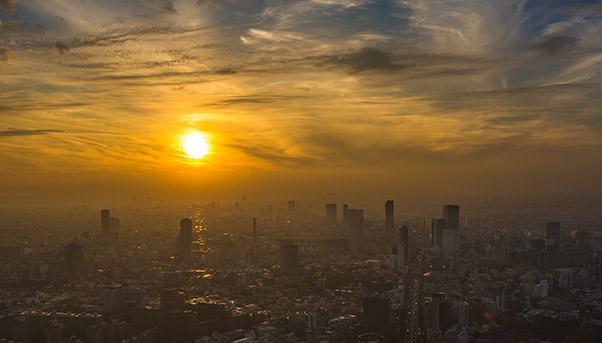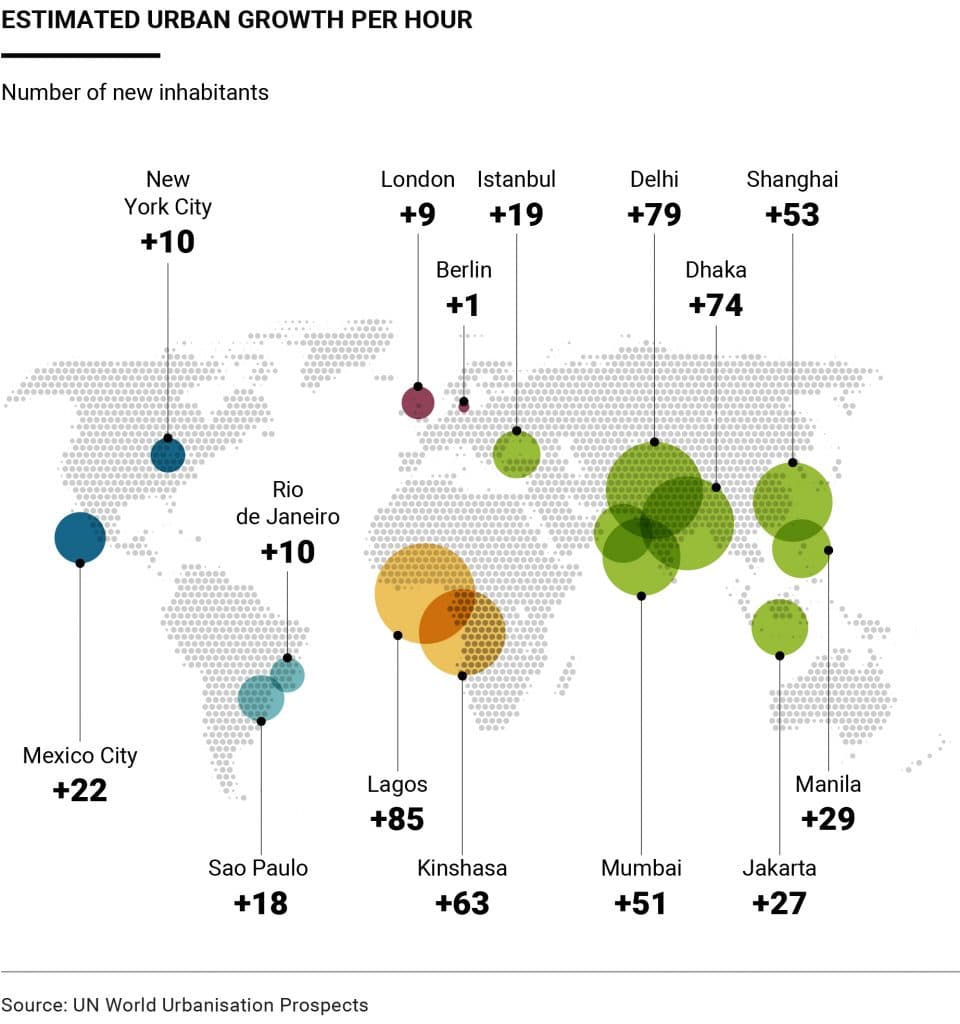
Every hour, 85 new inhabitants are registered in Lagos, 79 in Delhi, 53 in Shanghai, 51 in Mumbai and 22 in Mexico City. Although these cities are far from one another on different continents with distinct histories and traditions, they have one thing in common: unfettered growth. And this increasing rate of urbanisation will make infrastructure an essential tool for survival.
The trend is the subject of the latest edition of World Urbanization Prospects, published by the Population Division of the Department of Economic and Social Affairs of the United Nations. It shows a significant demographic increase in a few very large cities: Lagos, as mentioned, but also Delhi, Dhaka, Kinshasa, Manila, Istanbul, San Paolo and Jakarta. Most of these cities are in developing countries, and many are in Africa, where small towns have become unruly megacities in the space of a few dozen years – exactly like what happened in Lagos.
Lagos, the giant that came out of nowhere
Up until the 1960s, Lagos was little more than a coastal town, a group of houses surrounded by farming villages. In two generations, however, the city of 200,000 has grown to a sprawling giant with a population touching 20 million, making it Africa’s largest urban area and one of the biggest on the planet.
This happened because the Nigerian city became a magnet not just for Nigerians, but also for people of nearby countries looking for work or simply a better life. In the past 60 years, growth has been so consistent that Lagos today has become a megalopolis that is extremely hard to manage: it stretches across an area 1,000 square kilometres, and its main garbage dump measures 40 hectares and receives 10,000 tonnes of trash every day.
This uncontrolled growth underlines the fundamental role of basic infrastructure, from roads to water treatment. And Lagos needs more of everything because, according to the United Nations, it is expected to keep growing. If this demographic growth continues at the current rate, by 2100 Lagos will be an infinite expanse of 85-100 million inhabitants. So not only will it be the world’s largest city, but also an urban conglomeration surpassing the population of entire countries. Like England, for example.
Booming big cities
Lagos was among the cities studied by Daniel Hoornweg and Kevin Pope, two professors at the University of Ontario Institute of Technology. The results of their research were recently published by “The Guardian”.
Besides Lagos, they found that hundreds of small cities – mostly in Africa and Asia – are growing at a disproportional and rapid rate. The starkest example is little-known Niamey, the capital of Niger, which could explode from one million people to 46 million by 2100. Along these same lines, Blantyre in southern Malawi could become as large as New York City. The demographic boom, accompanied by inefficient management of urban development, may create 100 cities of more than 5.5 million inhabitants each in the next 35 years, shifting the center of gravity of the world’s largest cities to the point that by 2100 only 14 of the 100 largest will be in Europe or the Americas.

The effects of uncontrolled growth: Bangalore
Bangalore is emblematic of India’s economic growth. It is a city that boasts investment in innovation and technology. Its economic growth, however, has not gone hand in hand with urban planning. According to Hoornweg and Pope, its population is set to rise from seven million to 21 million by 2100. This growth mirrors India’s broader trendline. The country is on its way to becoming the world’s most populous by 2050, with 1.5 billion inhabitants, of which 600 million concentrated in its cities.
Bangalore is one of the leaders of this unstoppable race, but the effects – according to the Indian Institute of Science – are ominous. In the last 30 years, the city’s average temperature has risen 2.5 degrees; 88% of its vegetation has been lost; and weather-related events like flooding have become much more frequent. The solution – yet again – is a much more orderly development, better urban planning carried out with infrastructure investments and a growth strategy that makes sustainability and quality of life top priorities.
Copenhagen, an example for all
The research conducted by Hoornweg and Pope, along with the latest estimates by the United Nations, point to Copenhagen as an example for all: the population of Denmark’s capital will remain stable at 1.3 million inhabitants for the next 50 years. This constant can also be applied to the high quality of living that is supported by the city’s investment in infrastructure.
Take for example the Cityringen, the metro line under construction that will encircle the city and transport 72 million passengers annually. It demonstrates how an infrastructure project can serve as a tool to promote environmental sustainability, enabling Copenhagen to become one of the least car-dependent cities where 62% of residents use a bicycle for transport.
«Today our harbor is so clean we can swim in the water, and 62% of Copenhageners ride their bike to work or school every day», said Mayor Frank Jensen. «I want Copenhagen to maintain and further develop this position as a green and livable city».
Infrastructure, in turn, is contributing to a very ambitious goal: becoming the world’s first carbon neutral capital city by 2025. It would prove to be a significant victory for a European city that could be transformed into an example of sustainable development and a model for future megacities.

